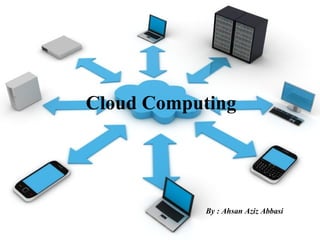Cloud Computing
- 1. Cloud Computing By : Ahsan Aziz Abbasi
- 2. Introduction:ï Cloud computing is a marketing term for technology ï End - user do not require any knowledge regarding system ï It gives ease-of-access to remote computing sites provided by the Internet ï Users can access and use facilities through a web browser ï Simply we can say cloud computing the delivery of computing as a service rather than a product Why Cloud Computing????
- 3. Characteristics:ï Security focused ï Empowerment of end-user ï Application programming interface (API) ï Cost efficient ï Agility of infrastructure ï Multi-tenancy of resources ï Reliability improved ï Scalability and Elasticity of resources ï Performance monitoring
- 4. Layers:-
- 5. 1. Cloud Infrastructure 2. Cloud Service 3. Cloud Platform 4. Cloud Storage
- 6. Types of Cloud Computing Model:- 1 Infrastructure as a Service (IaaS) In this architecture you're buying access to raw computing hardware over the Net, such as servers or storage. 2 Software as a Service (SaaS) In this architecture you use a complete application running on someone else's system 3 Platform as a Service (PaaS) In this you develop applications using Web-based tools so they run on systems software and hardware provided by another company.
- 7. Advantages:ïž Cloud computing allows you to buy in only the services you want ïž Avoid equipment going out of date ïž It's really quick and easy to add new applications or services to your business ïž A physical storage center is no longer needed. ïž Relieves burden on IT Professionals and frees up their time in the office ïž Easily scalable ïž Access your data at all times
- 8. Disadvantages:à Lost control comes with handing over your data and information à Depending on third-party to ensure the security and confidentiality of data and information à If your cloud host disappears, where does your information go? à Not applicable for small business à If you're using software as a service you need a reliable, high-speed, broadband Internet connection functioning the whole time you're working.
- 9. Conclusion:- Final Overview:There are some strong technical security arguments in favor of Cloud Computing assuming we can find ways to manage the risks.
- 12. References:ïHow stuff works http://communication.howstuffworks.com/ ïWikipedia http://en.wikipedia.org ïCloud security.org http://cloudsecurity.org ïAdvantages and Disadvantages http://www.cloudtweaks.com/2011/07/cloud-computingadvantages-disadvantages-infographic/ http://www.colocationamerica.com/dedicated_servers/adva ntages-and-disadvantages-of-cloud-computing.htm
- 13. Any Question??
- 14. Thank you!! Please give your feedbacks at : m_aa90@hotmail.com














